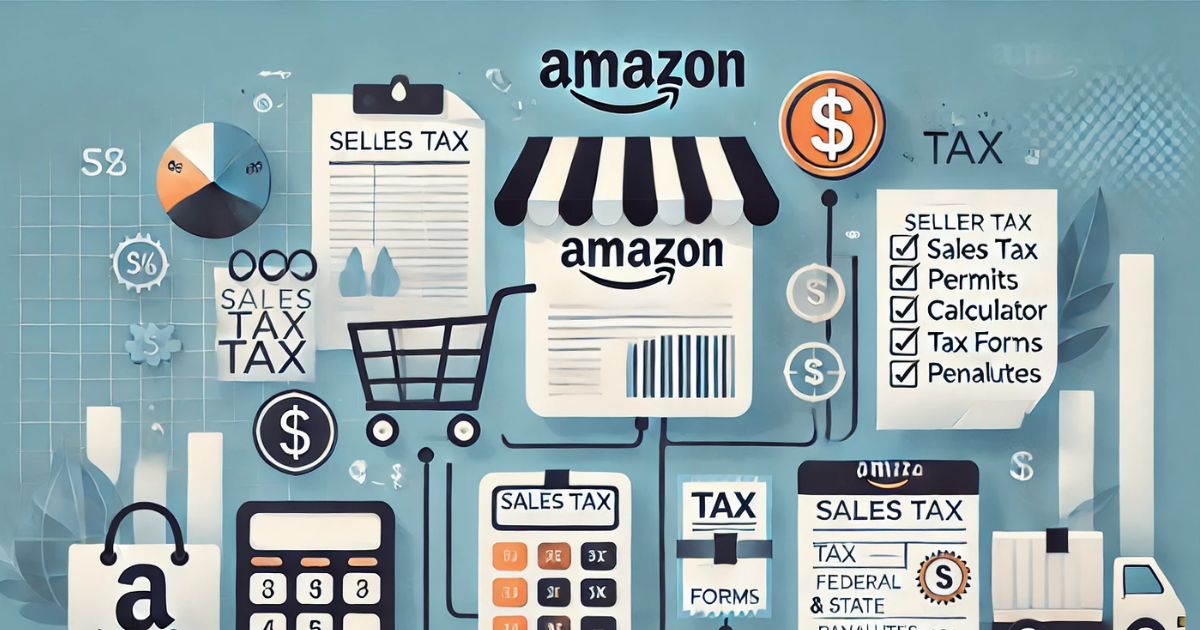
As an Amazon seller, understanding your tax obligations is crucial to running a compliant and successful business. Taxes for Amazon sellers can be complex, involving sales tax, income tax, and self-employment tax. Whether you’re just starting out or have been selling for years, staying informed about current amazon seller taxes with an Amazon Suspension Lawyer is essential to avoid penalties and ensure you’re meeting your legal responsibilities. In this guide, we’ll walk you through the different types of taxes Amazon sellers must pay, how to collect and remit sales tax, and tips to stay on top of your tax obligations.
What Taxes Do Amazon Sellers Have To Pay?
Amazon sellers are responsible for several types of taxes, depending on where they are based and where they sell their products. The most common taxes include:
- Sales tax: This is a consumption tax imposed on buyers for goods or services purchased. In many cases, Amazon sellers must collect sales tax on sales made to customers in certain states.
- Income tax: This is the tax you pay on the profits you earn from selling on Amazon.
- Self-employment tax: If you’re a sole proprietor, you are responsible for self-employment tax, which covers Social Security and Medicare.
Understanding the specific types of taxes that apply to you is the first step in ensuring compliance with sales tax laws and income tax regulations.
Sales Tax for Amazon Sellers
Sales tax is a key responsibility for Amazon sellers. Many states require sellers to collect and remit sales tax on products sold to customers within their borders. However, the sales tax nexus plays a crucial role in determining whether you are responsible for collecting sales tax in a particular state.
What Is Sales Tax Nexus?
A sales tax nexus is the connection between a business and a state that triggers a requirement to collect sales tax. This connection can be created through physical presence (like a warehouse or office) or through economic presence (such as selling a certain amount of goods to customers in that state). If you have sales tax nexus in a state, you must obtain a sales tax permit in that state and start collecting sales tax.
Marketplace Facilitator Laws
Many states now have marketplace tax collection laws, which require marketplaces like Amazon to collect sales tax on behalf of sellers. As a result, Amazon often handles sales tax collection for you. However, you are still responsible for ensuring that you are compliant with all sales tax laws and remitting any sales tax that is not collected automatically.
Income Tax and Amazon Sellers
In addition to sales tax, Amazon sellers are required to report their earnings and pay income tax. The income you earn from selling on Amazon is subject to federal and, in many cases, state income tax. In January of each calendar year, Amazon issues a 1099-K form that details your earnings if you surpass certain thresholds. You should use this form to report your earnings accurately when filing your taxes.
Calculating Your Taxable Income
To calculate your taxable income, you’ll need to subtract your business expenses from your total sales revenue. Some common expenses you can deduct include shipping costs, advertising expenses, and the cost of goods sold (COGS). Keeping accurate records of your sales and expenses is critical for minimizing your tax liability.
Self-Employment Tax for Amazon Sellers
If you are an independent seller operating as a sole proprietor, you are responsible for paying self-employment tax. This tax covers Social Security and Medicare contributions and is separate from your income tax obligations. The self-employment tax rate is currently 15.3%. Like with income tax, keeping track of your expenses can help reduce the amount of self-employment tax you owe.
Tax Deductions for Amazon Sellers
Amazon sellers can benefit from various tax deductions that help lower their taxable income. Some common deductions include:
- Shipping costs
- Cost of Goods Sold
- Advertising and marketing expenses
- Home office expenses
- Amazon seller fees
By keeping detailed records and utilizing these deductions, you can significantly reduce your overall tax liability.
Amazon Seller Tax Compliance
To stay compliant with tax regulations, you need to ensure that you are accurately collecting, reporting, and remitting all required taxes. Amazon provides several tools to help sellers manage their tax obligations, including the sales tax calculation report, marketplace tax collection report, and the combined sales tax report.
Seller Central Tools
In your Seller Central account, you can access the tax document library, where all your tax-related documents are stored. You can also generate various reports, such as sales tax reports, to review your sales tax collection over a specific period.
How To Collect and Remit Sales Tax as an Amazon Seller
Once you’ve established sales tax nexus in a state, you’ll need to start collecting sales tax from your customers. You can set up your Seller Central account to automatically charge sales tax based on the sales tax rate in the applicable states.
Steps to Collect and Remit Sales Tax
- Determine where you have sales tax nexus.
- Register for a sales tax permit in each state where you need to collect sales tax.
- Set up sales tax collection in your Seller Central account.
- Collect the appropriate sales tax from customers during checkout.
- Regularly review your sales tax reports to ensure accuracy.
- Remit sales tax to the appropriate tax authorities based on their deadlines.
Failing to remit sales tax on time can result in penalties and interest, so staying on top of your sales tax obligations is crucial.
International Amazon Sellers: Understanding US Tax Laws
If you are an international seller, you may still be subject to US tax laws if you sell to US-based customers. This can include both income tax and sales taxes. It’s essential to consult with a tax professional to ensure compliance with any treaties or withholding tax requirements that may apply to you.
Common Tax Mistakes Amazon Sellers Should Avoid
Even experienced sellers can make mistakes when it comes to taxes. Some of the most common errors include:
- Failing to register for a sales tax permit in states where they have sales tax nexus.
- Underreporting income on their 1099-K form.
- Neglecting to track business expenses, leading to missed deductions.
- Forgetting to regularly remit sales tax to state authorities.
To avoid these pitfalls, consider using tax software or working with a tax professional who specializes in eCommerce.
Conclusion
Understanding your tax obligations as an Amazon seller is key to running a compliant and successful business. From sales tax collection to paying income tax, staying organized and informed can save you from costly penalties. Make sure to take advantage of the tools in your Seller Central account, such as the tax document library and sales tax reports, to stay on top of your tax responsibilities. If you’re ever unsure about your tax obligations, it’s always wise to seek advice from a tax professional.
FAQs About Amazon Seller Taxes
What is the process for remitting sales tax as an Amazon seller?
Remitting sales tax involves submitting the sales tax you’ve collected from customers to the appropriate state tax authority. Amazon sellers must review their sales tax reports in their Seller Central account, determine how much they owe, and submit payment by the due date. Failing to properly remit sales tax on time can result in penalties or interest.
Does Amazon automatically collect and remit sales tax for me?
In many states, Amazon acts as a marketplace facilitator and is required to collect and remit sales tax on your behalf. However, this doesn’t cover all states or all types of transactions. It’s important to review your amazon sales tax settings in Seller Central to ensure you’re compliant with the sales tax collection requirements in every state where you have nexus.
Do I need a sales tax permit if Amazon collects and remits sales tax?
Even if Amazon collects and remits sales tax on your behalf, you may still be required to register for a sales tax permit in states where you have sales tax nexus. Some states require sellers to file sales tax returns, even if no tax is due, to keep the permit active.
How do I track the sales tax that Amazon collects on my behalf?
Amazon provides detailed reports in the Seller Central account, such as the sales tax calculation report and marketplace tax collection report. These reports help you track the amazon sales tax collected on your sales, ensuring that everything is accurately reported and remitted.
Can I set different sales tax rates for different states?
Yes, in your Seller Central account, you can set different sales tax rates based on the sales tax rates of each state where you have nexus. Amazon will then automatically calculate and collect the appropriate sales tax from your customers during checkout.
What happens if I fail to remit sales tax on time?
Failing to remit sales tax on time can result in penalties and interest from state tax authorities. It’s crucial to keep track of sales tax filing deadlines and remit the collected tax on time to avoid financial penalties.
How often do I need to remit sales tax as an Amazon seller?
The frequency with which you need to remit sales tax depends on the state’s tax laws and your total sales volume. Some states require monthly filing, while others may only require quarterly or annual filings. Always check with the tax authority in each state where you have nexus to ensure compliance.


